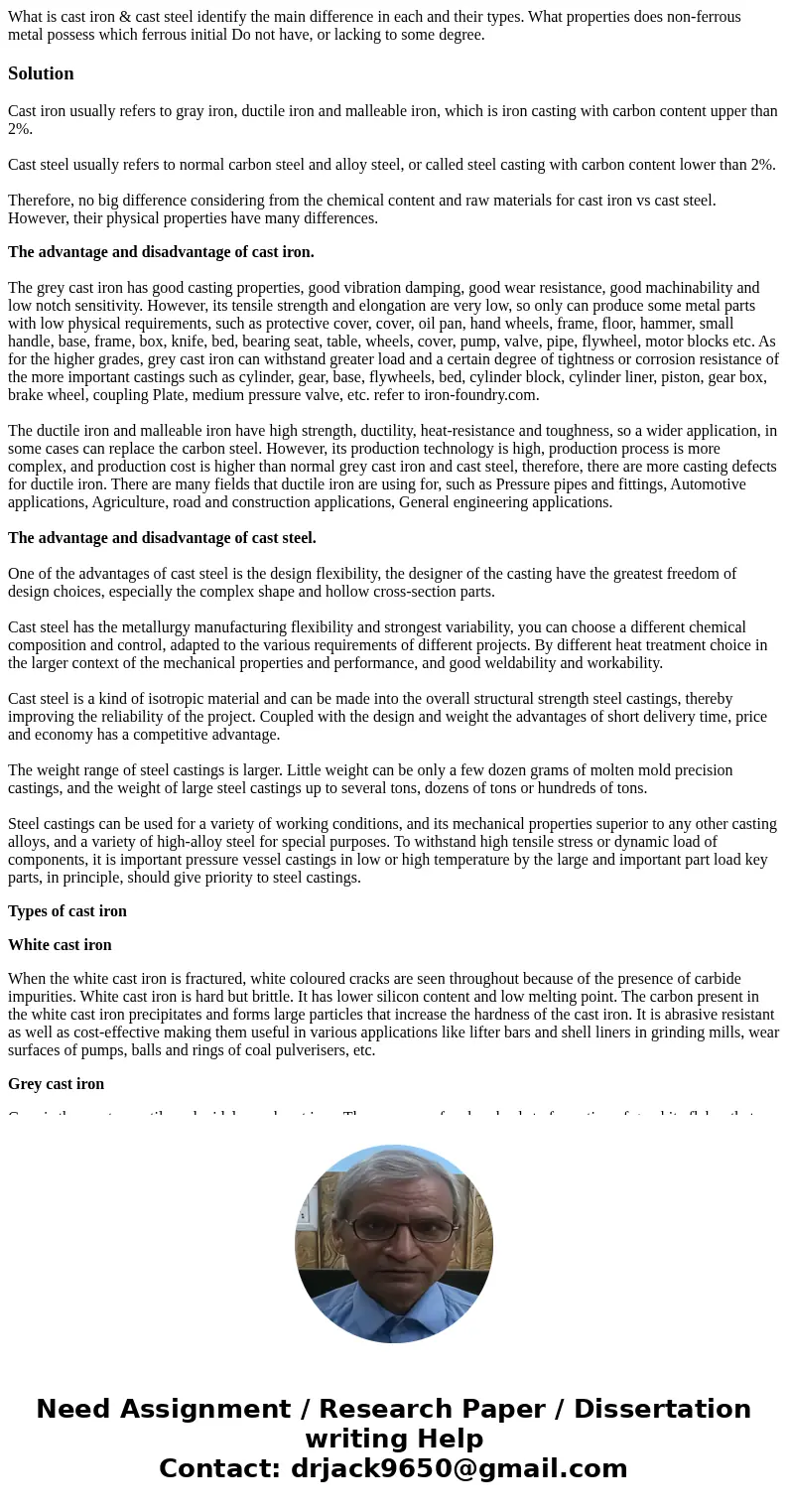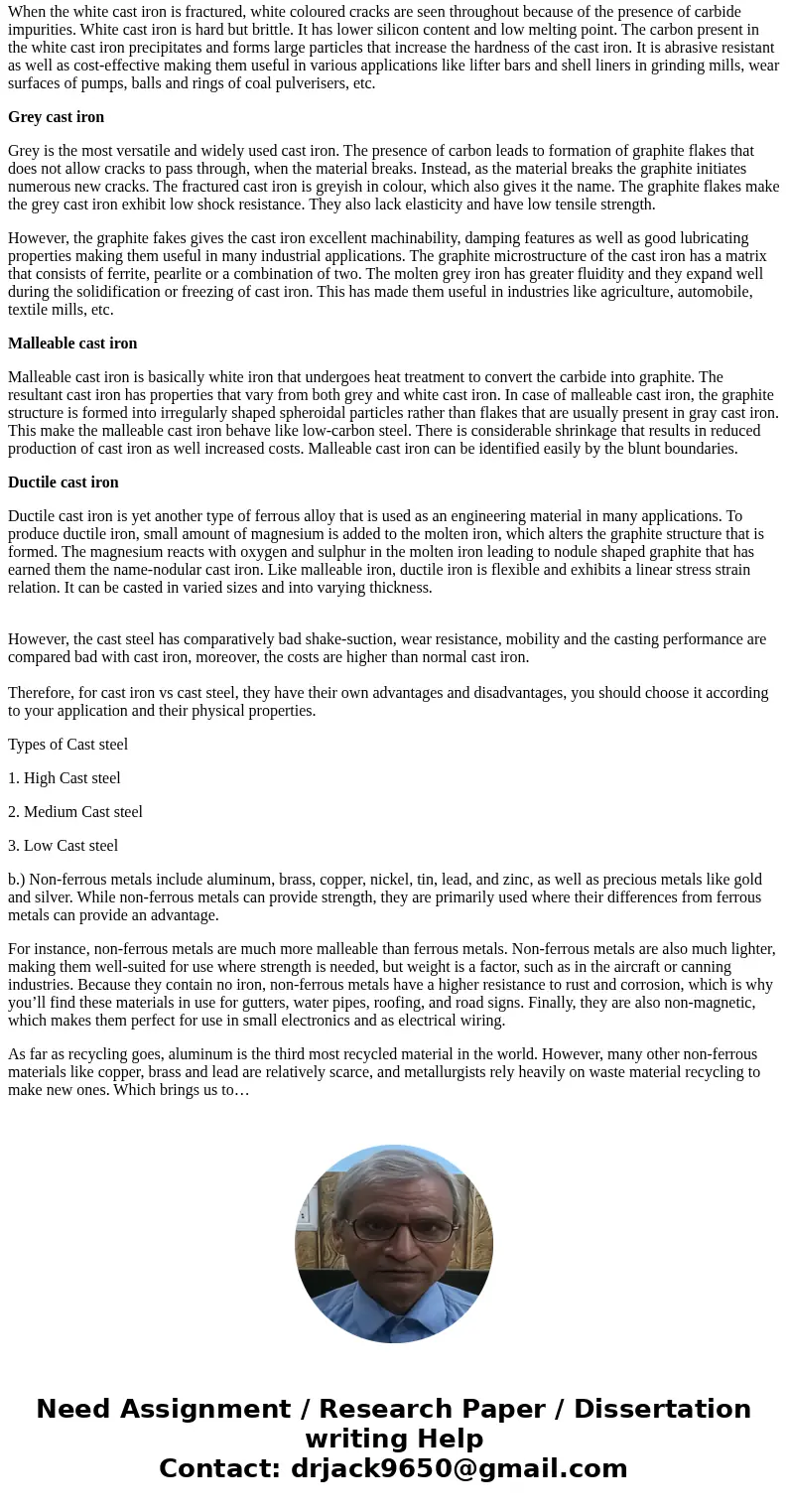What is cast iron cast steel identify the main difference i
Solution
Cast iron usually refers to gray iron, ductile iron and malleable iron, which is iron casting with carbon content upper than 2%.
Cast steel usually refers to normal carbon steel and alloy steel, or called steel casting with carbon content lower than 2%.
Therefore, no big difference considering from the chemical content and raw materials for cast iron vs cast steel. However, their physical properties have many differences.
The advantage and disadvantage of cast iron.
The grey cast iron has good casting properties, good vibration damping, good wear resistance, good machinability and low notch sensitivity. However, its tensile strength and elongation are very low, so only can produce some metal parts with low physical requirements, such as protective cover, cover, oil pan, hand wheels, frame, floor, hammer, small handle, base, frame, box, knife, bed, bearing seat, table, wheels, cover, pump, valve, pipe, flywheel, motor blocks etc. As for the higher grades, grey cast iron can withstand greater load and a certain degree of tightness or corrosion resistance of the more important castings such as cylinder, gear, base, flywheels, bed, cylinder block, cylinder liner, piston, gear box, brake wheel, coupling Plate, medium pressure valve, etc. refer to iron-foundry.com.
The ductile iron and malleable iron have high strength, ductility, heat-resistance and toughness, so a wider application, in some cases can replace the carbon steel. However, its production technology is high, production process is more complex, and production cost is higher than normal grey cast iron and cast steel, therefore, there are more casting defects for ductile iron. There are many fields that ductile iron are using for, such as Pressure pipes and fittings, Automotive applications, Agriculture, road and construction applications, General engineering applications.
The advantage and disadvantage of cast steel.
One of the advantages of cast steel is the design flexibility, the designer of the casting have the greatest freedom of design choices, especially the complex shape and hollow cross-section parts.
Cast steel has the metallurgy manufacturing flexibility and strongest variability, you can choose a different chemical composition and control, adapted to the various requirements of different projects. By different heat treatment choice in the larger context of the mechanical properties and performance, and good weldability and workability.
Cast steel is a kind of isotropic material and can be made into the overall structural strength steel castings, thereby improving the reliability of the project. Coupled with the design and weight the advantages of short delivery time, price and economy has a competitive advantage.
The weight range of steel castings is larger. Little weight can be only a few dozen grams of molten mold precision castings, and the weight of large steel castings up to several tons, dozens of tons or hundreds of tons.
Steel castings can be used for a variety of working conditions, and its mechanical properties superior to any other casting alloys, and a variety of high-alloy steel for special purposes. To withstand high tensile stress or dynamic load of components, it is important pressure vessel castings in low or high temperature by the large and important part load key parts, in principle, should give priority to steel castings.
Types of cast iron
White cast iron
When the white cast iron is fractured, white coloured cracks are seen throughout because of the presence of carbide impurities. White cast iron is hard but brittle. It has lower silicon content and low melting point. The carbon present in the white cast iron precipitates and forms large particles that increase the hardness of the cast iron. It is abrasive resistant as well as cost-effective making them useful in various applications like lifter bars and shell liners in grinding mills, wear surfaces of pumps, balls and rings of coal pulverisers, etc.
Grey cast iron
Grey is the most versatile and widely used cast iron. The presence of carbon leads to formation of graphite flakes that does not allow cracks to pass through, when the material breaks. Instead, as the material breaks the graphite initiates numerous new cracks. The fractured cast iron is greyish in colour, which also gives it the name. The graphite flakes make the grey cast iron exhibit low shock resistance. They also lack elasticity and have low tensile strength.
However, the graphite fakes gives the cast iron excellent machinability, damping features as well as good lubricating properties making them useful in many industrial applications. The graphite microstructure of the cast iron has a matrix that consists of ferrite, pearlite or a combination of two. The molten grey iron has greater fluidity and they expand well during the solidification or freezing of cast iron. This has made them useful in industries like agriculture, automobile, textile mills, etc.
Malleable cast iron
Malleable cast iron is basically white iron that undergoes heat treatment to convert the carbide into graphite. The resultant cast iron has properties that vary from both grey and white cast iron. In case of malleable cast iron, the graphite structure is formed into irregularly shaped spheroidal particles rather than flakes that are usually present in gray cast iron. This make the malleable cast iron behave like low-carbon steel. There is considerable shrinkage that results in reduced production of cast iron as well increased costs. Malleable cast iron can be identified easily by the blunt boundaries.
Ductile cast iron
Ductile cast iron is yet another type of ferrous alloy that is used as an engineering material in many applications. To produce ductile iron, small amount of magnesium is added to the molten iron, which alters the graphite structure that is formed. The magnesium reacts with oxygen and sulphur in the molten iron leading to nodule shaped graphite that has earned them the name-nodular cast iron. Like malleable iron, ductile iron is flexible and exhibits a linear stress strain relation. It can be casted in varied sizes and into varying thickness.
However, the cast steel has comparatively bad shake-suction, wear resistance, mobility and the casting performance are compared bad with cast iron, moreover, the costs are higher than normal cast iron.
Therefore, for cast iron vs cast steel, they have their own advantages and disadvantages, you should choose it according to your application and their physical properties.
Types of Cast steel
1. High Cast steel
2. Medium Cast steel
3. Low Cast steel
b.) Non-ferrous metals include aluminum, brass, copper, nickel, tin, lead, and zinc, as well as precious metals like gold and silver. While non-ferrous metals can provide strength, they are primarily used where their differences from ferrous metals can provide an advantage.
For instance, non-ferrous metals are much more malleable than ferrous metals. Non-ferrous metals are also much lighter, making them well-suited for use where strength is needed, but weight is a factor, such as in the aircraft or canning industries. Because they contain no iron, non-ferrous metals have a higher resistance to rust and corrosion, which is why you’ll find these materials in use for gutters, water pipes, roofing, and road signs. Finally, they are also non-magnetic, which makes them perfect for use in small electronics and as electrical wiring.
As far as recycling goes, aluminum is the third most recycled material in the world. However, many other non-ferrous materials like copper, brass and lead are relatively scarce, and metallurgists rely heavily on waste material recycling to make new ones. Which brings us to…


 Homework Sourse
Homework Sourse